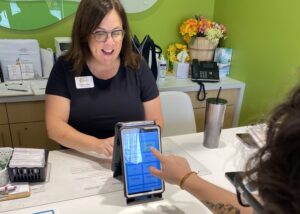Laura Choate was just 11 years old when she was kicked out of her family home for coming out. At times in her youth, she had to eat out of garbage cans and beg for food. So it isn’t hard for her now, as the food pantry director at the Church of the Open Arms, to put herself in the shoes of the clientele.
Situated close to what’s known as the gay district in Oklahoma City, the church was created to welcome members of that community, alongside everyone else. The pantry has the same ethos. About one-fourth of the people they serve identify as lesbian, gay, bisexual, transgender or queer (LGBTQ), including minors living at their youth shelter whose families have cut them out because of their sexuality.

Serving them is as simple as being kind, Choate says. “Sometimes people come in dressed differently, but we don’t pay any attention to it,” she said. Volunteers are instructed to “treat them like anyone else. Ask them what they want to be called – he or she – and try to stick with that.”
Yet it’s not that simple in many places. Members of the LGBTQ community are more likely to face discrimination and stigma at food pantries, particularly those affiliated with religious institutions.
LGBTQ people routinely experience staring, looks of disapproval, or even disgust. In 2020, the Williams Institute at the University of California Los Angeles interviewed LGBTQ people about their experiences with food charities and some shared that they were asked to pray as part of the shared meal. When asked if they ever avoided a food pantry because they were concerned about bias against them, 14% said yes.
In a BMC Public Health study based in the Southeast United States the same year, transgender and gender non-conforming people reported feeling unwelcome at food pantries. Although 79% of those surveyed reported food insecurity, only 22% utilized local food assistance resources. One person reported being asked to sit through a church service where the pastor spoke out against homosexuality.
Such barriers get in the way of helping a population that is disproportionately affected by hunger. During the pandemic, more LGBT people with a high school degree or less (23%) experienced food insufficiency than non-LGBT people with the same level of education (13%), according to the Williams Institute. A variety of reasons, including less stable housing and jobs, make people who identify as LGBT more susceptible to food insecurity.
Many hunger relief organizations have made it part of their mission to welcome all people. In California, the Alameda County Community Food Bank states publicly that its mission to “create a hunger-free community” includes “everyone and doesn’t discriminate based on gender or sexual orientation.”
In Oklahoma, Choate says the pantry is very clear with new volunteers about how to treat people who look different. Having that conversation upfront is important to ensure that they don’t bat an eye when someone comes in with a beard, a wig and a dress.
“We’re an open and affirming church,” she said. “We just don’t make a big deal out of anything. It is simple.”
Choate said providing services to minors requires extra sensitivity, since many young people who have run away from home are afraid of being caught and sent back. “Home is not necessarily a safe place if they’ve been kicked out,” she said.
The pantry doesn’t directly serve minors, but delivers boxes of food to the youth shelter housed at the church. Regardless of who is being served, Choate said friendliness goes a long way.
“Sometimes we’re the only smile these people see all week,” she noted. “Especially the homeless, nobody’s smiling at them.” – Ambreen Ali
Ambreen Ali is a freelance journalist and the founder of Central Desi, a newsletter about New Jersey’s South Asian community. She has published widely on politics, technology, parenting and food.
Like what you’re reading?
Support Food Bank News








